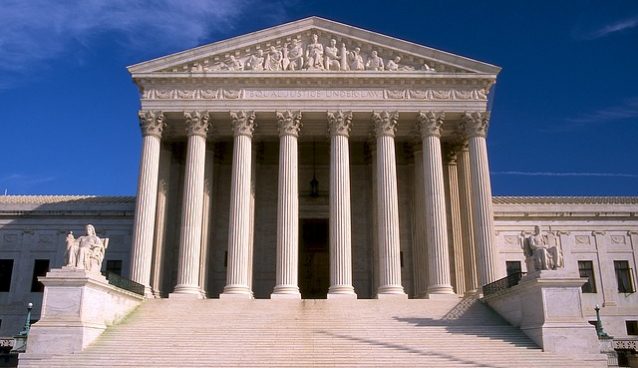Top U.S. Supreme Court Decisions of 2017

The U.S. Supreme Court returned to full strength in 2017 with the nomination of Justice Neil Gorsuch. He was sworn in on April 10, 2017, despite a Democratic filibuster. As expected, Justice Gorsuch has voted very conservatively since joining the bench.
The Trump Administration has also been involved in a number of high-profile cases. Most notably, the Supreme Court has allowed the President’s so-called travel ban to take effect while lawsuits challenging its provisions work their way through the Court. Below is a brief summary of the Court’s other significant decisions of 2017:
Matal v. Tam: The Court struck down the Lanham Act’s prohibition of registering disparaging trademarks with the U.S. Patent and Trademark Office, concluding that the ban was unconstitutional under the First Amendment. “We now hold that this provision violates the Free Speech Clause of the First Amendment,” Justice Samuel Alito wrote. “It offends a bedrock First Amendment principle: Speech may not be banned on the ground that it offends.”
Pena-Rodriguez v. Colorado: A divided U.S. Supreme Court held that while jury deliberations should normally be kept secret, racial or ethnic bias mandates an exception to the rule. Where a juror makes a clear statement indicating that he or she relied on racial stereotypes or animus to convict a criminal defendant, the Sixth Amendment requires that the no impeachment rule give way in order to permit the trial court to consider the evidence of the juror’s statement and any resulting denial of the jury trial guarantee,” Justice Anthony M. Kennedy wrote.
Buck v. Davis: The Court determined that a death row inmate was likely prejudiced by expert witness testimony offered by his own defense team that suggested he was more likely to be dangerous in the future because he was black. Accordingly, the six-member majority held Duane Buck is entitled to a new sentencing hearing. “When a jury hears expert testimony that expressly makes a defendant’s race directly pertinent on the question of life or death, the impact of that evidence cannot be measured simply by how much air time it received at trial or how many pages it occupies in the record. Some toxins can be deadly in small doses,” Chief justice John Roberts wrote.
Cooper v. Harris: The Court struck down two congressional redistricting maps in North Carolina. By a vote of 5-3, the majority held that the District Court did not err in concluding that race was the predominant rationale for a North Carolina district’s redesign. The Court further held that the state’s interest in complying with the Voting Rights Act (VRA) could not justify that consideration of race. “The Constitution entrusts states with the job of designing congressional districts,” Justice Elena Kagan explained. “But it also imposes an important constraint: A state may not use race as the predominant factor in drawing district lines unless it has a compelling reason.”
Fry v. Napoleon Community Schools: The Court unanimously held that exhaustion of the administrative procedures established by the Individuals with Disabilities Education Act (IDEA) is unnecessary when the gravamen of the plaintiff’s suit is something other than the denial of the IDEA’s core guarantee of a “free appropriate public education.” The suit, brought by parents of a girl born with cerebral palsy, alleged that her school violated Title II of the Americans with Disabilities Act by refusing to allow her service dog to attend school with her. The Court determined that the Frys may not have been required to exhaust the IDEA’s administrative proceedings before pursuing a lawsuit in federal court. “Nothing in the nature of the Frys’ suit suggests any implicit focus on the adequacy of (Elena’s) education,” Justice Elena Kagan wrote. “The Frys could have filed essentially the same complaint if a public library or theater had refused admittance to Wonder.”
Bethune-Hill v. Virginia State Board of Elections: The Court held that the district court applied an incorrect legal standard in a redistricting case involving 12 challenged Virginia legislative districts. The Court first held that the District Court erred when it required the challengers to establish, as a prerequisite to showing racial predominance, an actual conflict between the enacted plan and traditional redistricting principles. “The Equal Protection Clause does not prohibit misshapen districts. It prohibits unjustified racial classifications,” Justice Anthony Kennedy explained. The Court also rejected the state’s argument that race does not have a prohibited effect on a district’s lines if the legislature could have drawn the same lines in accordance with traditional criteria. “The racial predominance inquiry concerns the actual considerations that provided the essential basis for the lines drawn,” Justice Kennedy wrote, “not post hoc justifications the legislature, in theory, could have used but in reality did not.”
Trinity Lutheran Church of Columbia v. Comer: The Court held that the State of Missouri violated the U.S. Constitution’s Free Exercise Clause when it rejected a state grant application by the Trinity Lutheran Church of Columbia solely because it is a religious institution. The policy “violated the rights of Trinity Lutheran under the Free Exercise Clause of the First Amendment by denying the Church an otherwise available public benefit on account of its religious status.” Chief Justice John Roberts, Jr. wrote on behalf of the majority.
Turner v. United States/ Overton v. United States: The Court refused to grant new trials to several defendants convicted of the brutal 1984 murder of Catherine Fuller in Washington, D.C. The defendants had argued that prosecutors withheld evidence that was both favorable to the defense and material to their guilt in violation of Brady v. Maryland, 373 U.S. 83 (1963). As Justice Stephen Breyer explained, the withheld evidence was “too little, too weak, or too distant from the main evidentiary points to meet Brady’s standards.”
